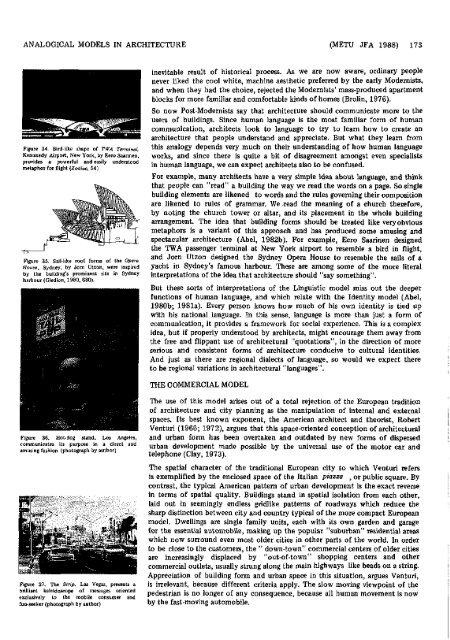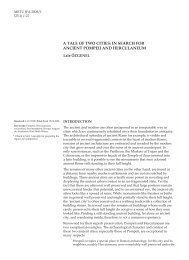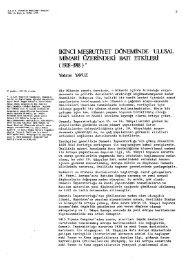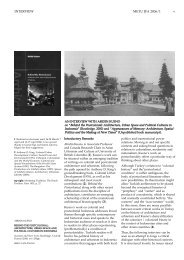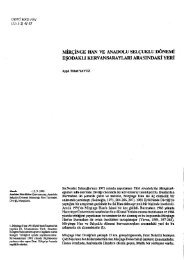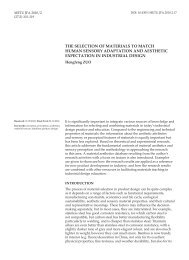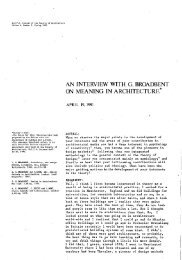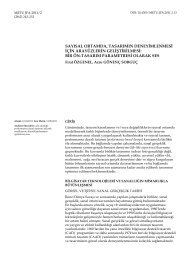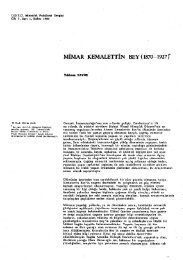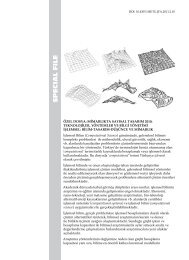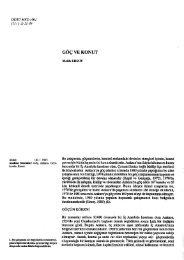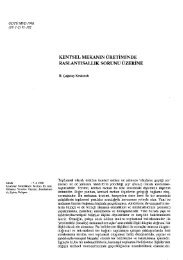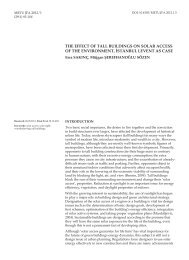ANALOGICAL MODELS IN ARCHITECTURE AND URBAN DESIGN l
ANALOGICAL MODELS IN ARCHITECTURE AND URBAN DESIGN l
ANALOGICAL MODELS IN ARCHITECTURE AND URBAN DESIGN l
You also want an ePaper? Increase the reach of your titles
YUMPU automatically turns print PDFs into web optimized ePapers that Google loves.
<strong>ANALOGICAL</strong> <strong>MODELS</strong> <strong>IN</strong> <strong>ARCHITECTURE</strong> (METU JFA 1988) 173<br />
Figure 34. Bird-like shape of TWA Terminal,<br />
Kennnedy Airport, New York, by Eero Saarinen,<br />
provides a powerful and easily understood<br />
metaphor for flight (Zodiac, 54)<br />
Figure 35. Sail-like roof forms of the Opera<br />
House, Sydney, by Jom Utzon, were inspired<br />
by the building's prominent site in Sydney<br />
harbour (Giedion, 1980, 680).<br />
Figure 36. Hot-dog stand, Los Angeles,<br />
communicates its purpose in a direct and<br />
amusing fashion (photograph by author)<br />
vmmm<br />
Figure 37. The Strip, Las Vegas, presents a<br />
brilliant kaleidoscope of messages oriented<br />
exclusively to the mobile consumer and<br />
fun-seeker (photograph by author)<br />
inevitable result of historical process. As we are now aware, ordinary people<br />
never liked the cool white, machine aesthetic preferred by the early Modernists,<br />
and when they had the choice, rejected the Modernists' mass-produced apartment<br />
blocks for more familiar and comfortable kinds of homes (Brolin, 1976).<br />
So now Post-Modernists say that architecture should communicate more to the<br />
users of buildings. Since human language is the most familiar form of human<br />
communication, architects look to language to try to learn how to create an<br />
architecture that people understand and appreciate. But what they learn from<br />
this analogy depends very much on their understanding of how human language<br />
works, and since there is quite a bit of disagreement amongst even specialists<br />
in human language, we can expect architects also to be confused.<br />
For example, many architects have a very simple idea about language, and think<br />
that people can "read" a building the way we read the words on a page. So single<br />
building elements are likened to words and the rules governing their composition<br />
are likened to rules of grammar. We read the meaning of a church therefore,<br />
by noting the church tower or altar, and its placement in the whole building<br />
arrangement. The idea that building forms should be treated like veryobvious<br />
metaphors is a variant of this approach and has produced some amusing and<br />
spectacular architecture (Abel, 1982b). For example, Eero Saarinen designed<br />
the TWA passenger terminal at New York airport to resemble a bird in flight,<br />
and Jorn Utzon designed the Sydney Opera House to resemble the sails of a<br />
yacht in Sydney's famous harbour. These are among some of the more literal<br />
interpretations of the idea that architecture should "say something".<br />
But these sorts of interpretations of the Linguistic model miss out the deeper<br />
functions of human language, and which relate with the Identity model (Abel,<br />
1980b; 1981a). Every person knows how much of his own identity is tied up<br />
with his national language. In this sense, language is more than just a form of<br />
communication, it provides a framework for social experience. This is a complex<br />
idea, but if properly understood by architects, might encourage them away from<br />
the free and flippant use of architectural "quotations", in the direction of more<br />
serious and consistent forms of architecture conducive to cultural identities.<br />
And just as there are regional dialects of language, so would we expect there<br />
to be regional variations in architectural "languages".<br />
THE COMMERCIAL MODEL<br />
The use of this model arises out of a total rejection of the European tradition<br />
of architecture and city planning as the manipulation of internal and external<br />
spaces. Its best known exponent, the American architect and theorist, Robert<br />
Venturi (1966; 1972), argues that this space-oriented conception of architectural<br />
and urban form has been overtaken and outdated by new forms of dispersed<br />
urban development made possible by the universal use of the motor car and<br />
telephone (Clay, 1973).<br />
The spatial character of the traditional European city to which Venturi refers<br />
is exemplified by the enclosed space of the Italian piazza , or public square. By<br />
contrast, the typical American pattern of urban development is the exact reverse<br />
in terms of spatial quality. Buildings stand in spatial isolation from each other,<br />
laid out in seemingly endless gridlike patterns of roadways which reduce the<br />
sharp distinction between city and country typical of the more compact European<br />
model. Dwellings are single family units, each with its own garden and garage<br />
for the essential automobile, making up the popular "suburban" residential areas<br />
which now surround even most older cities in other parts of the world. In order<br />
to be close to the customers, the " down-town" commercial centers of older cities<br />
are increasingly displaced by "out-of-town" shopping centers and other<br />
commercial outlets, usually strung along the main highways like beads on a string.<br />
Appreciation of building form and urban space in this situation, argues Venturi,<br />
is irrelevant, because different criteria apply. The slow moving viewpoint of the<br />
pedestrian is no longer of any consequence, because all human movement is now<br />
by the fast-moving automobile.


